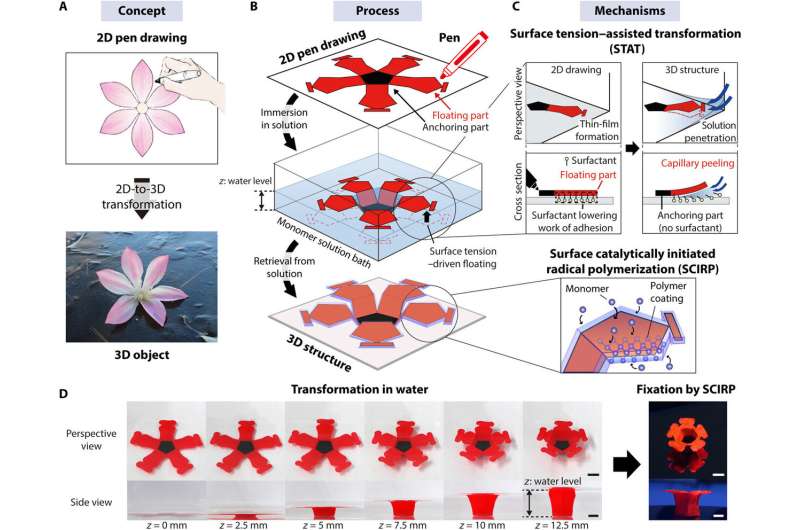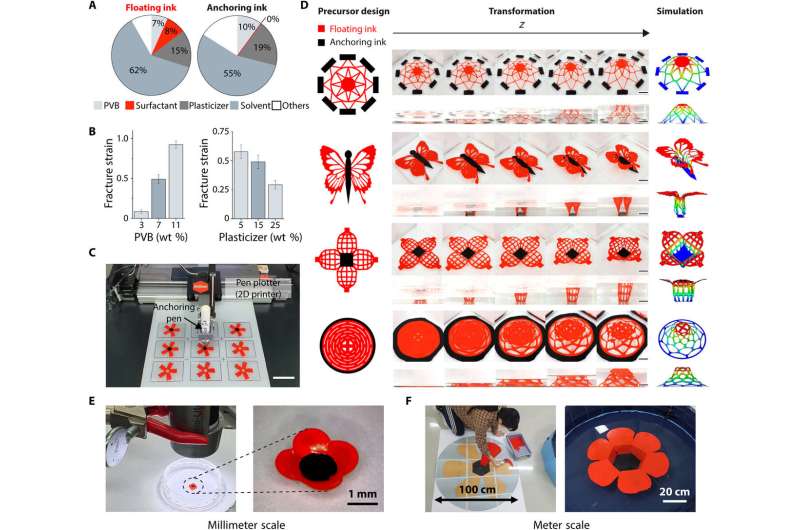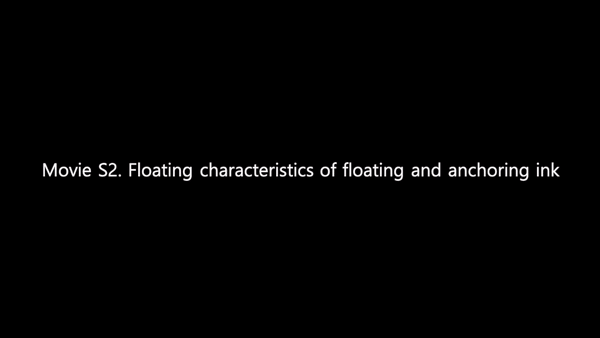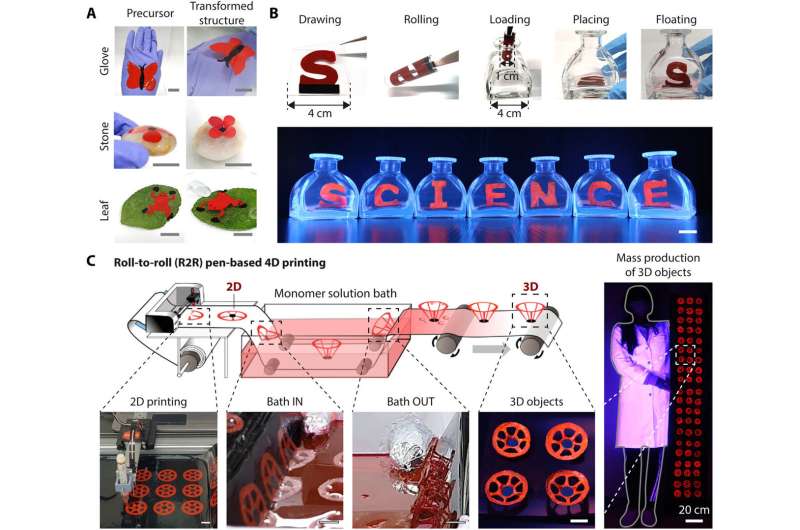April 1, 2021 feature
Direct 2D-to-3D transformation of pen drawings

Pen drawings can allow simple, inexpensive and intuitive two-dimensional (2D) fabrication. Materials scientists aim to integrate such pen drawings to develop 3D objects. In a new report now published on Science Advances, See Woo Song et al. developed a new 3D fabrication method to directly transform pen-drawn 2D precursors into 3D geometries. The team facilitated the 2D-to-3D transformation of pen drawings using surface tension driven capillary peeling and floating of the dried ink film after dipping the drawing into an aqueous monomer solution. By selectively controlling and anchoring the parts of a 2D precursor, Song et al. transformed a 2D drawing into the designed 3D structure. They then fixed the transformed 3D geometry using structural reinforcement using surface-initiated polymerization. The scientists transformed simple pen-drawn 2D structures into complex 3D architectures to accomplish freestyle rapid prototyping with pen drawings including the mass production of 3D objects through roll-to-roll processing.
The 2D-to-3D method
Two-dimensional planar structures can be transformed into 3D forms using a strategy of 2D-to-3D based technology. The method of 2D fabrication is simple and suited for mass production, although its output is limited to planar structures. In comparison, 3D structures can form tangible real-world objects for a variety of structures albeit in a slow and complex process. The 2D to 3D transformation processes can therefore increase throughput and simplicity during 3D fabrication from 2D initial precursors. In this work, Song et al. developed pen-based 4D printing to form floating 3D architectures directly from 2D pen drawings in a monomer solution. The team based the method on a shape-morphing mechanism relying on surface tension-driven selective peeling and floating of dried ink in a process known as 'surface tension-assisted transformation' (STAT). the process is simple and intuitive, without high technical procedures to predict the resulting transformation. The pen-based 4D printing process only required drawing pens and a monomer solution for accessible 3D structure formation. Computer-aided design (CAD) and automatic printing systems can be introduced for more precise fabrication and mass production.

Surface tension-assisted transformation (STAT)
When a 2D drawing entered the monomer solution, the polyvinyl butyrate (PVB) film could be peeled depending on the thermodynamic work of adhesion. For example, commercial dry-erase markers include surfactants that lower the adhesion of the ink to create a drawing that can be easily peeled off of a substrate. When the team removed surfactants from the ink, they could easily peel off the material. Based on the principle, Song et al. developed a floating ink with surfactant and an anchoring ink without surfactant to draw the floating and anchoring aspects of an art. When they submerged such an art into the solution, the parts drawn in floating ink with a low adhesion could be peeled away from the intended 3D structure. The scientists used a computer-aided pen-drawing system for better precision and mass production with high reproducibility.
Structural reinforcement by surface catalytically initiated radical polymerization (SCIRP).

Song et al. easily transformed the 2D polyvinyl butyrate film into designed, complex 3D structures using STAT (surface tension-assisted transformation). They could only maintain the structure underwater due to the interfacial tension between the floating component and the surface of the water. As a result, the team developed a structural reinforcement method using SCIRP to allow the 3D object to retain its structure outside water. The scientists developed this method on the basis of preceding work on hydrogel coatings with iron microparticles. The team used the SCIRP process to float ink containing iron microparticles and a monomer solution containing potassium persulfate (KPS) instead of standard floating ink and water. The iron particles accelerated the decomposition of persulfate ions to create free radicals at the surface of the PVB (polyvinyl butyrate) film. The researchers determined the optimal conditions for SCIRP to be 40 percent of the iron microparticles in the floating ink with 3-min incubation. They controlled the final 3D structures based on the design of the initial 2D drawing and the depth of the monomer solution. Using polymers, the team captured the images using blue-ultraviolet light to visualize the transformation.
Pen-based 4D printing
The pen-based approach allowed a high degree of freedom when selecting a printing substrate, the scientists showed how the pen-based 4D printing can be applied to create 3D structures on a variety of substrates including glass, plastic, poly (dimethyl siloxane) PDMS, and even on natural surfaces such as stone and leaf. The work allowed 3D fabrication in locations that are difficult to print using conventional 3D printing processes, the team used the method to create an "impossible bottle" and to "3D print everywhere." The team then used roll-to-roll (R2R) processing with 4D printing to show the mass production of 3D objects on a large area of thin and flexible polyvinyl chloride film. The team expect these methods to be applicable to develop new possibilities during rapid and mass 3D fabrication.

In this way, See Woo Song and colleagues showed how pen-based 4D printing provided an easy and intuitive method to construct 3D structures from lower dimensional printed structures. These methods can lower the manufacturing time and cost. Using this technique, scientists will be able to further develop simple and efficient methods for 3D fabrication via 2D technologies with expansion to 4D printing.
More information: Song S. W. et al. Direct 2D-to-3D transformation of pen drawings, Science Advances, 10.1126/sciadv.abf3804
Sun Y. et al. Controlled buckling of semiconductor nanoribbons for stretchable electronics, Nature Nanotechnology, doi.org/10.1038/nnano.2006.131
Cera L et al. A bioinspired and hierarchically structured shape-memory material, Nature Materials, doi.org/10.1038/s41563-020-0789-2
Journal information: Nature Nanotechnology , Nature Materials , Science Advances
Provided by Science X Network
© 2021 Science X Network




















